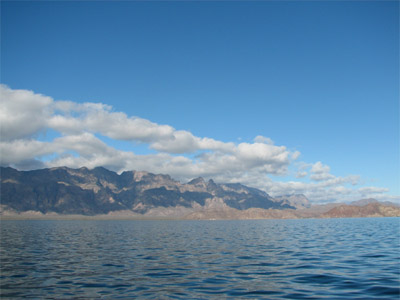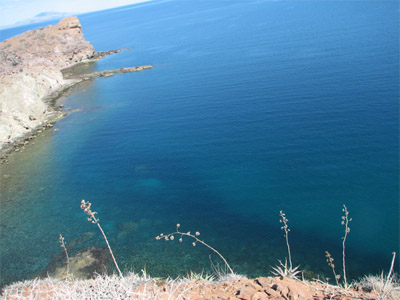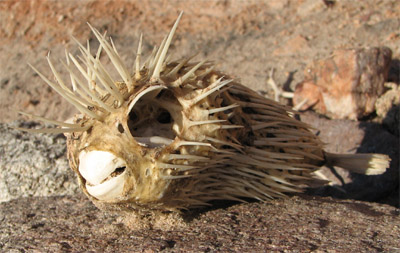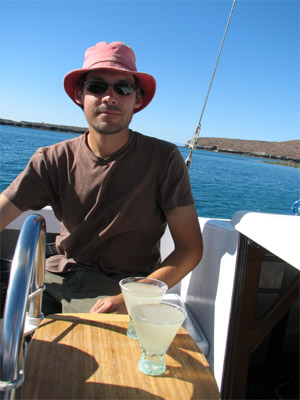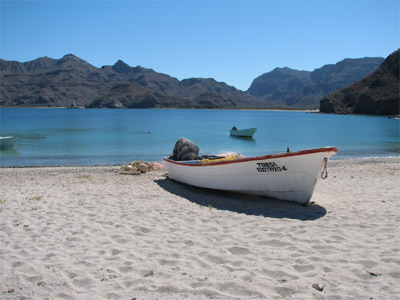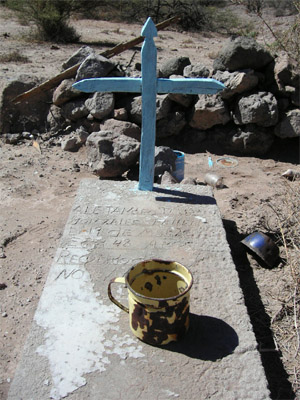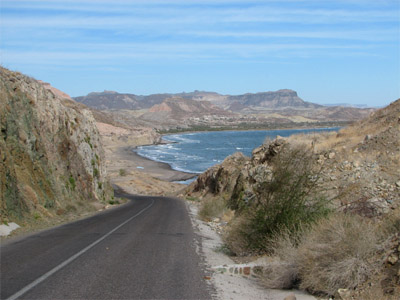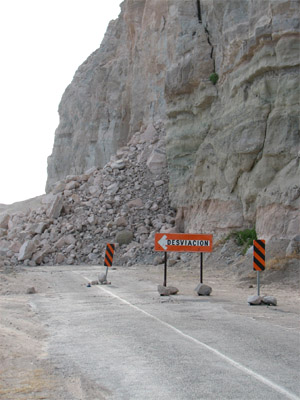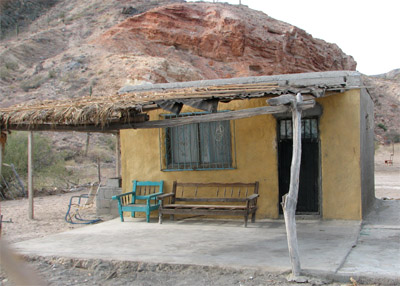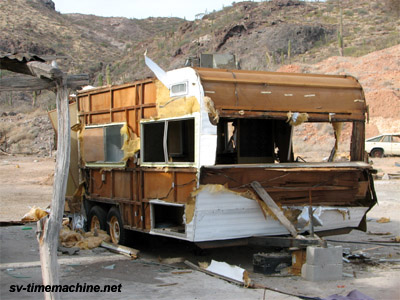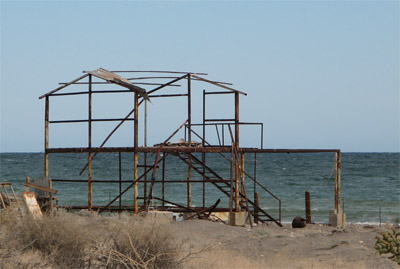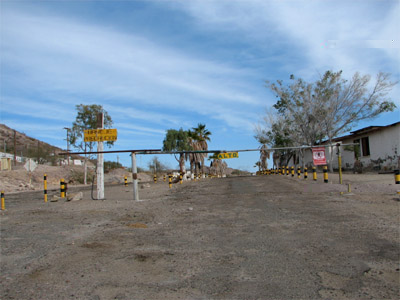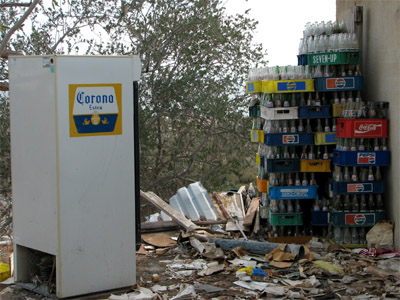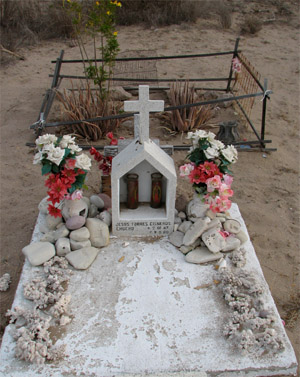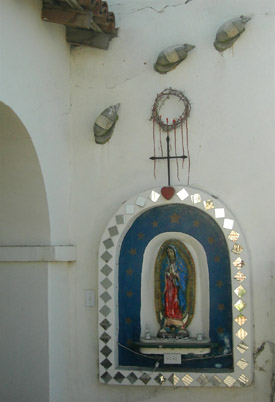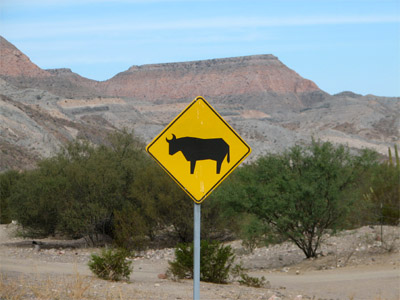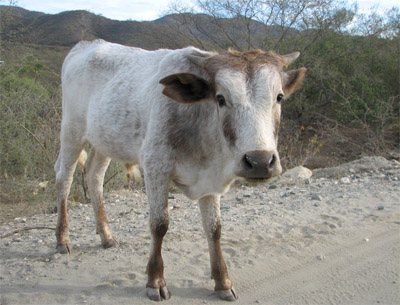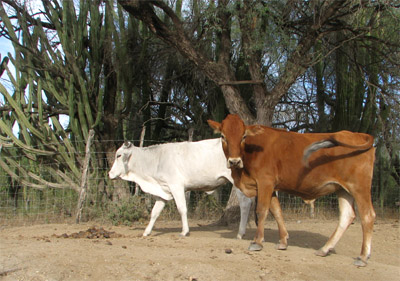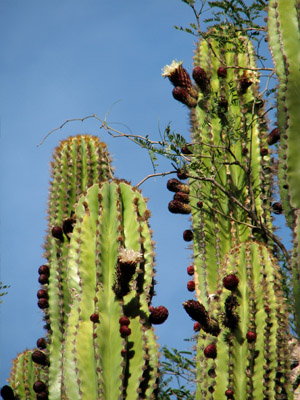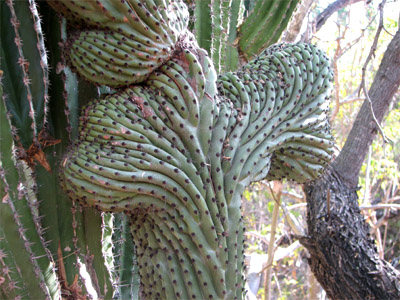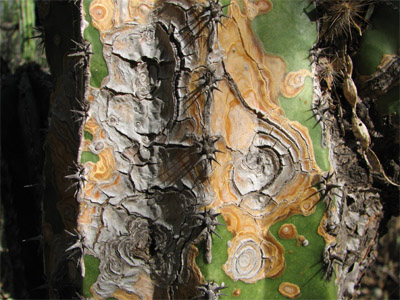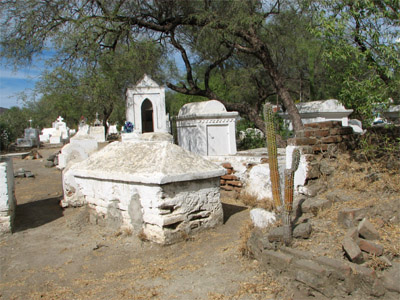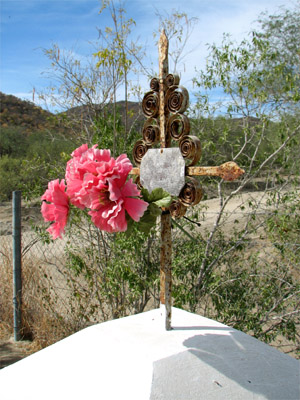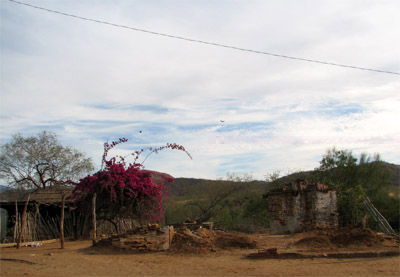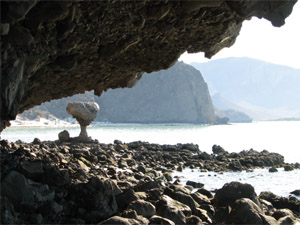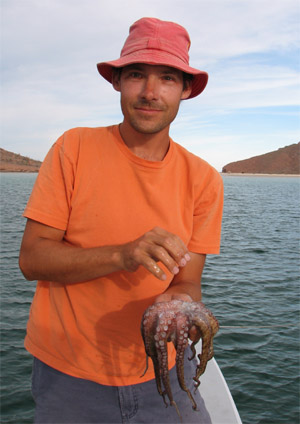Puerto Escondido
Monday, February 13th, 2006Puerto Escondido is the one of the ‘hurricane holes’ on the Sea of Cortez. It has a mile-long lagoon with a teeny tiny opening of maybe 50 meters. The immediate land area seems to have been under construction for ages but nothing has really come of it yet. So there is an empty neighborhood grid of streets and sidewalks with lampposts at every 200 meters or so but the streets are growing weeds through all the cracks and there are no actual buildings anywhere. A concrete boat launch ramp is just outside entrance of the lagoon with a sunken sailboat next to it, then a circular anchoring area with a concrete wall around it. There is a place where larger vessels can tie up and a couple of official-ish looking buildings surrounded by fences saying “Prohibito el Paso.†Supposedly there was free water for anyone who wanted it but when we found the spigot a day later, it was locked up. Directly outside of the lagoon entrance and concrete circular area/launch ramp is a very deep natural anchorage called the “Waiting Room†where boats were supposed to hang out waiting for favorable conditions to enter the lagoon (tides, crowding, etc.); however, this anchorage was absolutely full of boats, and the lagoon had hardly any. We motored directly into the lagoon to check things out and discovered the entire thing was a field of mooring balls—at least 100 of them. There were maybe 25 boats (tops) inside and most of them looked unoccupied. We were tweaked out by the place and wanted to anchor outside near the entrance, but there was just no space; we ended up having to anchor in the lagoon. We went ashore that evening to find the supposed water and garbage and walked around for a long time finding nobody and nothing that looked like water or garbage.
The next day before dawn, we headed out for Loreto, 15 miles to the north. We had zero wind and motored the entire way for crying out loud. We arrived in Loreto around 9:30 and anchored off the beach (there is absolutely no protection here so you have to keep an eye out for wind). We ate some awesome fish tacos, took some photos of the old cathedral, bought some veggies (limes were getting low! Ack scurvy!!!), and got some potable water for our jug. By the time we got back to the boat at noon, there were big fat whitecaps and some sprightly chop. I got soaked in the kayak back to the boat (all of 100 meters). I decided my outfit was ruined and we would not be going back to town for another load of water and fuel (we were down approximately five gallons from all the motoring we had done the previous couple of weeks) and headed back to Escondido.
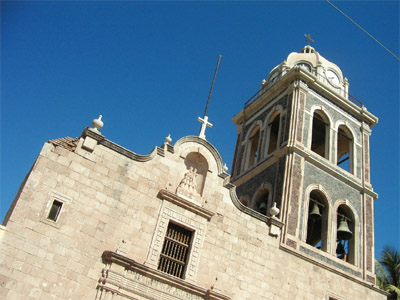
(Old quaint mission at Loreto.)
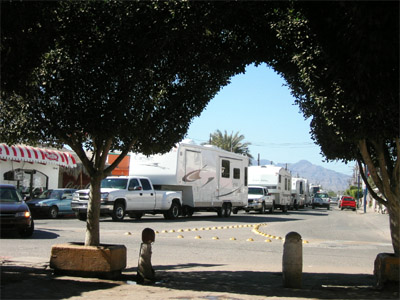
(Invasion of the Good Sams!)
Back in Escondido, again anchored in the lagoon, we at last found a guy named David to give us the scoop; he had lived there for the past 25 years.
“Man, I’ve been here for 25 years. This place used to be just a beach [gesturing at the concrete circular retaining wall where he was anchored, directly outside of the lagoon] and we’d just pull our dinghies up on the beach with whatever fish we caught that day. There was a Mexican family who lived on the beach and the woman would take your fish and for like a dollar, clean it and cook it for you. She could cook a fish too! We’d just hang out with them on the beach eating fish and drinking beer and watching the day grow dark. There’s no beach here anymore, obviously. You see they have this law in Mexico says that all playas are public property; so they built this wall here and presto! Now it’s not a playa anymore. Those of us who’ve been here so long built that dinghy dock so we could actually get to shore. You see they’ve been doing construction for a long time here; I don’t know what they think they’re going to do with it. They put those curbs and sidewalks in last year for that whole grid of streets; there’s no wiring or plumbing or anything underneath them though. All those lampposts? These guys come and paint them green every so often. Then they steal the bulbs out of them; take ‘em back to Loreto. Not that there’s any electricity for them anyway. Gotta love ‘em! So a private company took control of the place here recently and kicked all of us out of the lagoon; now they think they are going to charge $1 per foot per day to anchor there! What a joke. That’s why the Waiting Room and this place are so crowded. They put in all those mooring balls to rent out; I saw them make them—the concrete bottom’s fine, but they embedded polypropylene rope and not chain to the mooring ball [and ultimately the boat tied to it]. That stuff chafes so badly—that’s what happened to that boat over there [pointing at the sunken boat by the launch ramp]. In fact, those mooring balls come loose periodically even without boats pulling on them; there’s one floating around right inside the entrance there. And that construction there? [Some vague building scaffolding and concrete nearby with a bunch of workers milling around.] That’s supposed to be finished in April! Hah! And that Pemex station? [Right next to the scaffolding.] They are expecting boats to Med-moor up to the gas station while they pump the gas. This all exposed to the north! What a sight that would be during a norther.â€
It was depressing listening to how much things had gone downhill since the good ol’ days but David was pretty damned cheerful about it all. “The cruiser’s net in the mornings. We cruisers started that way back when; ‘course now most of them are radioing in from land. Funny how they give up the boating life, move onto the land and think they own something.†It was fun talking to him and he had many good stories to tell. He said that the La Paz Cruiser’s Club was started after too many cruisers began making a habit of hanging out on the beach across from Hotel Los Arcos drinking beer with the local guy who kept watch over the dinghies (they would bring him things from town, like beer, to thank him, then help him drink it). Well, more than ten drunk gringos on the beach equals An Unlawful Gathering, which was a threat to the State of Mexico in the ‘80s, and something had to be done. Luckily Hotel Los Arcos opened their doors and said they would be happy sell the gringo cruisers as much beer as they could drink any day of the week. So this became the new hangout and thus was born the Club Cruceros.
He told us where we could get water that wasn’t locked. “Shit! We’re the ones who put that water in; that private company came and locked it up. There are nine freshwater wells at the foot of those mountains…â€
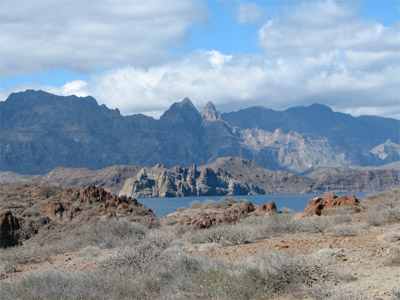
(These mountains.)
“We have the best water around too. People from Loreto used to come here to get water! Too many people shitting upstream of the water in Loreto. Nobody shitting upstream of our water here!â€
Another norther was coming through, according to the morning weather net, and we hoped to ride it back to La Paz. We awoke to dry decks, pulled anchor, and escaped Puerto Escondido before They wised up to us anchoring (and not paying) in their $1/foot/day harbor.
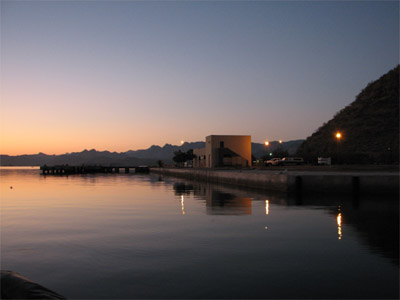
(Escape from Puerto Escondido at dawn.)
